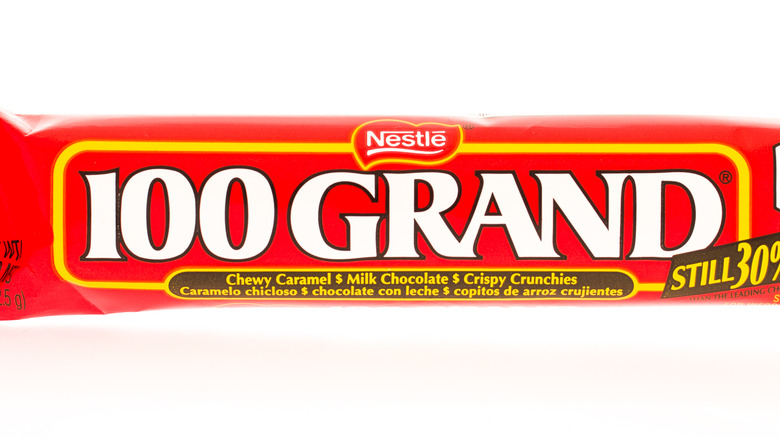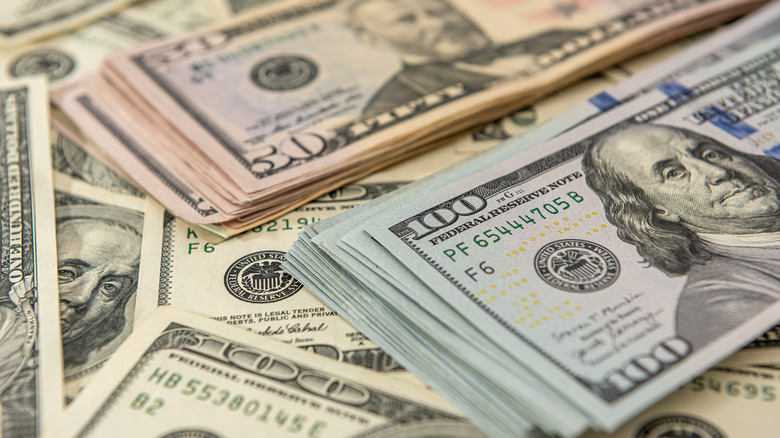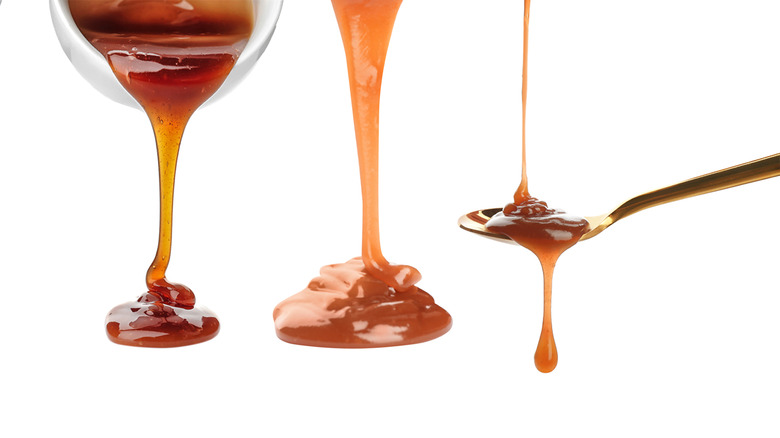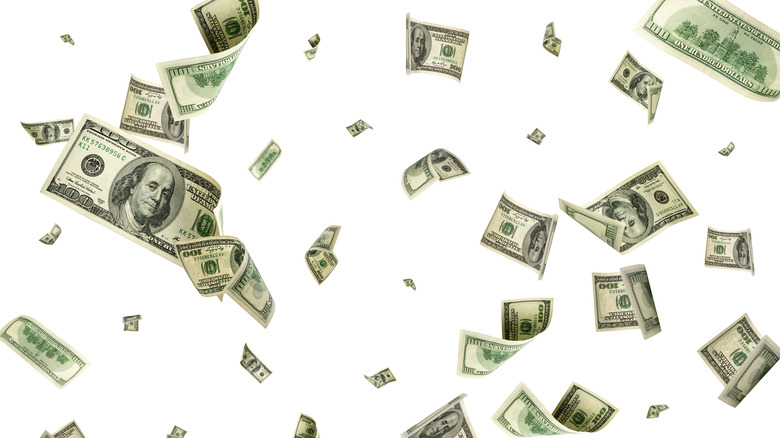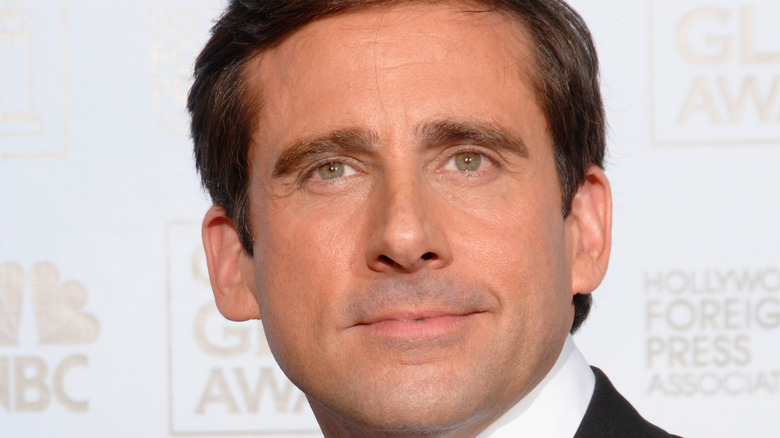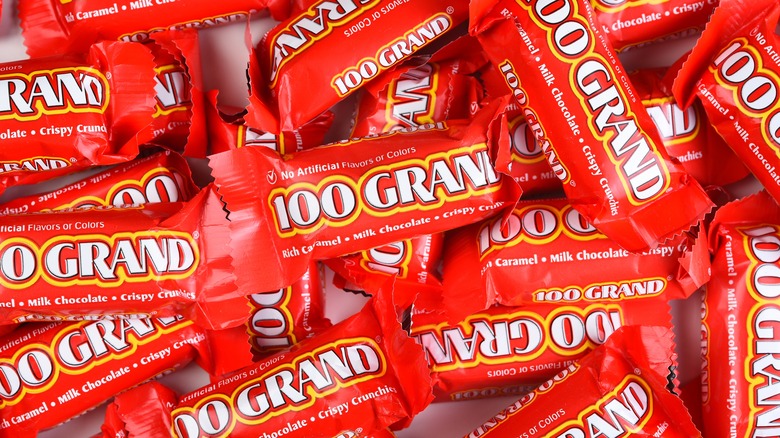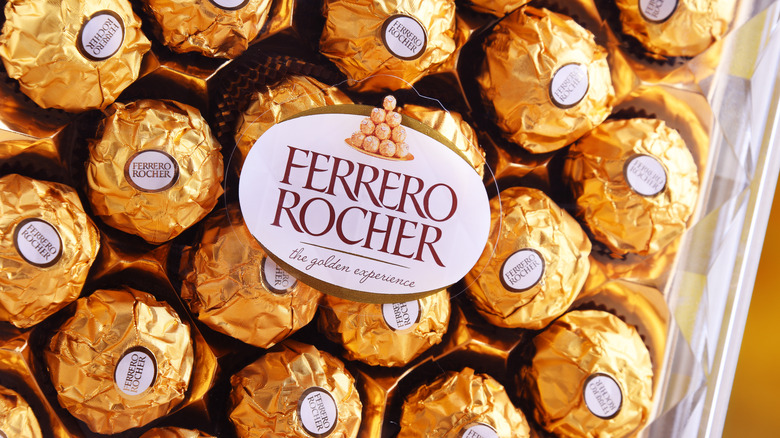The Untold Truth Of 100 Grand
Can we offer you 100 Grand?
Before you get too excited, we're not talking money here, but, rather, a candy bar. Expectations adjusted? Great — because, believe it or not, it's still a tantalizing offer. 100 Grand is a classic candy bar and stalwart favorite, per Snack History. Made from milk chocolate, caramel, and crisped rice, it's aptly named thanks to its richness and has proven to be a true crowd-pleaser ever since it was first invented in the '60s by Nestle.
That said, jokes and plays on words with its name haven't always gone over so well. From tongue-in-cheek appearances in classic sitcoms to well-meaning, but often devastating, pranks, there's far more to 100 Grand than meets the eye. It even inspired a lawsuit in Kentucky!
The time has come to delve into this bar's ambiguous name, fraught history, and, of course, its tantalizing flavor to discover what makes it so eternally popular among consumers.
100 Grand isn't this candy's original name
100 Grand is a pretty catchy name, so it may come as a surprise to learn that it wasn't what this candy bar was called when it was invented by Nestle back in 1964 (per Snack History). Originally dubbed the $100,000 Bar (or "hundred thousand dollar bar" aloud), its appeal was predicated on its richness right off the bat. A 1964 ad for the bar, according to Collecting Candy, even claimed it "tastes so good it's almost illegal."
In some foreign markets, the bar got even more zeroes: Due to currency differences, South Africa's version of the candy was called the $1,000,000 Bar!
Per Snack History, the modern name of this candy took hold in the mid-1980s (some say because Nestle had an easier time trademarking the phrase "100 Grand" than "$100,000"). Whatever the reason, 100 Grand has held fast ever since (it's definitely got a nice ring to it, doesn't it?).
100 Grand is made with chocolate, caramel, and crisped rice
The 100 Grand bar begins with two common American candy staples: milk chocolate and gooey caramel. The latter makes up the bulk of the bar, leading Candy Addict to state that the 100 Grand is far more akin to chocolate-coated caramel than a caramel-filled chocolate bar. It also boasts the added textural element of crispy puffed rice that Crunch bar fans know and love, breaking up some of the natural richness of the bar with a pleasant crunch.
Original iterations of the bar were sold in one piece, per Candy Favorites, much like other popular candies like Snickers or Three Musketeers. It wasn't until 1984, just a year before the bar's name changed from $100,000 bar to 100 Grand bar that it was divided into two smaller servings, much like Twix or Almond Joy. The resulting bar, thus, has even more chocolate coating than the original large bar.
100 Grand was inspired by a game show
Inspiration can come from anywhere, and when it comes to the 100 Grand bar, it seems to have stemmed from '60s quiz shows, of all places (per Candy Favorites). Popular programs of the time, such as "The Big Surprise" and "The $64,000 Question," offered huge payouts and cash prizes. The ambiguous evocation of a big sum in the name of a delicious, but relatively inexpensive, candy bar must have seemed too tantalizing to ignore for Nestle (Candy Addict compares the candy giant's choice of name to someone making a "Millionaire Bar" in the wake of the success of "Who Wants to Be a Millionaire?").
But while 100 Grand certainly seems like a fun name in theory, the choice would prove to be far from all fun and games in practice. Indeed, when you think you've been promised cash and get candy instead, things can get a little bit... hairy.
100 Grand was the subject of a big lawsuit
It's no surprise that with a name like 100 Grand, this bar was just begging to be used by pranksters. Indeed, it soon became common for radio presenters to tell contest winners they'd won 100 grand — only to deliver the prize, not in cash, but in chocolate (via Gopuff).
While receiving a payout in candy is certainly disappointing, one Kentucky woman took her dismay to the next level in the early aughts, when, after listening to a radio show for several hours to be the 10th caller at a specific time, she learned that her promised "100 grand" prize was to be in the form of a single chocolate bar. As CBS News noted, the incensed woman sued Atlanta-based Cumulus Media, owner of WLTO-FM in Lexington, Kentucky, after learning the truth.
According to a Godfrey & Kahn news release, while the radio host offered $5,000 in additional compensation after the misleading mishap, the winner was nonplussed, claiming that the misinformation led her to make promises to her kids that she could no longer keep.
100 Grand appeared as a gag in The Office
100 Grand's kooky name also landed it a cameo on "The Office." In the Season 3 episode "Business School," everyone's favorite boss, Michael Scott, relies on wordplay as an excuse to pelt his audience with a Whatchamacallit, a PayDay, and 100 Grand as part of a motivational speech intended to inspire. "If you sell enough of them," he says as he tosses the bars into the sea of unimpressed listeners, "you will make a 100 Grand."
And this isn't the only time 100 Grand made it onto a top sitcom — or, at least, onto the set of one. According to one urban legend, boxes of the candy were ostensibly sent to the cast of "Friends" in 1996, when the six leads demanded $100,000 per episode (via Answers to All). The actors didn't confirm or deny the story, but we bet Matt LeBlanc was happy not to have to share his food!
100 Grand used to come in multiple flavors
It's not uncommon for producers of popular candy bars to make forays into alternative flavors — consider just how many versions of Snickers, Reese's, and M&Ms are on the market today! The makers of 100 Grand have attempted the same, in the past, with versions featuring dark chocolate (the healthier kind of chocolate) or peanuts popping up at various points in the candy's long and illustrious history, per Snack History.
According to Candy Addict, the limited edition 100 Grand Dark Bar, which was marketed until 2006, featured an almost overpowering aroma of chocolate upon first opening. The flavor of the dark chocolate, the blogger notes, was intense and opulent, despite the bar they tasted being past its best by date. "One can only hope Nestle fathoms the possible greatness of this bar," the site notes of the even-richer 100 Grand alternative, "and decides to reissue it as a permanent addition to their confectionery lineup."
100 Grand is now owned and produced by Ferrero
While 100 Grand was initially developed and produced by Nestle in 1964, it's now made by Ferrero, as noted by USA Today, a family business three generations strong that is best known as the producer of candies like Ferrero Rocher as well as everyone's favorite chocolate-hazelnut spread, Nutella.
The Italian company bought the rights to the entirety of Nestle's American candy business in 2018 (via Confectionary News). Of its U.S. presence, Nestle retained only its baking, beverage, frozen, coffee, pet food, and baby food lines. With the purchase, Ferrero acquired not just 100 Grand but also 20 other well-known candy brands, including Baby Ruth, Laffy Taffy, Oh Henry!, Butterfinger, and Goobers (via Confectionary News). The $2.8 billion purchase (that's 28,000 100 Grand bars, for those doing the math) made Ferrero the third-largest chocolate maker on the planet, trailing Hershey and Mars, according to market research company Euromonitor International (per USA Today). Now that's a rich, indulgent buy!
